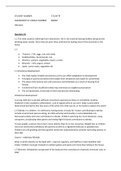STUDENT NUMBER 57124779
ASSIGNMENT 02 UNIQUE NUMBER 885067
HEC101V
Question 01
1.1 The child could be suffering from malnutrition. He or she could be lacking healthy eating and be
drinking water mostly. Since they are poor they could also be lacking most of the essentials in the
home.
1.2
Proteins – Fish, eggs, nuts and seeds
Carbohydrates- bread cereal, rice
Vitamins- spinach, vegetables, beans, carrots
Minerals – milk, yogurt, cheese
Lipids- some meats, vegetable oils
1.3 Emotional development
The child maybe irritable and anxious as this can affect adaptation to development
A hungry or poorly nourished child maybe short tempered and unable to concentrate
The obese child may be very self-conscious and withdrawn as a result of teasing from
friends.
A child tired from insufficient sleep may overreact at a slightest provocation
The overprotected, chronically ill child may become demanding.
Intellectual development
A young child who is denied sufficient movement experiences illness or immobility could be
hindered in later academic achievement. Lack of opportunity to use one’s body is particularly
determined during the first few years of life when the child uses his or her body to explore the world
1.4 Obesity in a children. It is defined as having excess in body fat. Factors contributing to obesity
include environment (excess eating, too little activity) and heredity in some debatable mix.
Decreased activity level also contributes to obesity. Children watching too much television, using
computers, and playing video games and eating high-fat foods contributes to obesity.
To lose weight, a person has to burn more calories than he or she consumes. Weight loss in children
has to be monitored carefully by the parents as well as a registered dietician or paediatrician.
Children are still growing and their growth cannot be compromised by severely restricting calories in
their diet.
Causes – sedentary lifestyle
Ways in which obesity can be dealt with – exercise regularly, eat healthy or clean healthier diet
intake. Children must get involved in outdoor games and spots a lot more than sitting in the house.
1.5 Minerals- Metabolism and growth of the body and the manufacture of genetic chemicals such as
DNA
, Question 02
2.1 Primary prevention- involves children immunization. Getting and increasing knowledge and
promoting initial behaviours health-supporting and health enhancing. Teaching children to eat well
and to exercise well, to get sufficient rest, and to minimise stress in their earliest childhood.
Secondary prevention- is realising what the problem is as early as possible and making either
prevention or means to manage the problem. It can be to prevent it from spreading further or
maintaining it at the lowest level. After identifying the problem you react quickly to keep it from
growing.
Tertiary prevention- refers to actions taken to control or minimise irreversible damage. It slows the
disease progression while maximising adjustment and resumption of life’s activities.
2.2 health risk factors are characteristics or patterns of behaviours that are associated with the
potentials for developing an illness or disease
Health behaviours is a major is a major factor in determining health. It has been defined as “any
activity undertaken by a person believing himself/herself to be healthy, for the purpose of
preventing disease or detecting it in an asymptomatic stage.”
2.3 A health Promoting School is one which aims at achieving healthy lifestyle for the total school
population by developing supportive environments conductive to the promotion of health. It offers
opportunities for and requires commitments to, the provision of a safe and health-enhancing social
and physical environment.
Criteria for a Health promoting school.
1. Commitment to the improvement of the physical, social and psychological environment of the
school.
2. Promotion of learners’ self-esteem.
3. Good teacher-leaner and peer group relations.
2.4 Self-esteem is having a positive feeling and view of self and the world, being open to knowing
and accepting oneself and the surrounding world, and having a sense of autonomy or independence
in thought or action.
Self-love can be defined as a strong positive attachment to oneself. People express self-love through
a set of actions or behaviours that strive to fulfil the basic needs of sleep, food, shelter, safety,
comfort and care given in a supportive consistent manner.
2.5 The relationship between stress and disease is complex, involving the interaction between the
nervous, endocrine, and immune system.
Disease related to an over-responsive autonomic nervous system, which produces migraine
headache, ulcers, and coronary heart diseases
Disease related to dysfunctional immune system, which invites colds, influenzas and cancers.




